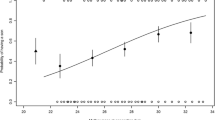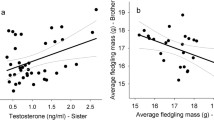Abstract
Male body size influences mate choice and sexual selection in many animal species. Here we investigate the role of male body size in the reproductive success of the field cricket Gryllus firmus. This species hybridizes with a close smaller relative, G. pennsylvanicus, and it is thought that this size difference may affect reproductive isolation between these species. We paired large and small G. firmus males with a single G. firmus female and genotyped the resulting offspring. Overall, larger males sired a greater proportion of offspring and in a majority of the crosses the larger male sired all of the offspring. For crosses in which both males sired offspring, there was no difference in the proportion of offspring sired by small and large males. Intrasexual competition, female choice, and differences in ejaculates between males could all influence the patterns we observe. We discuss the implications of our findings within the context of reproductive isolation between G. firmus and G. pennsylvanicus.



Similar content being viewed by others
References
Alexander RD (1961) Aggressiveness, territoriality, and sexual behavior in field crickets (Orthoptera: Gryllidae). Behaviour 17(2/3):130–223
Alexander RD (1968) Life cycle origins, speciation, and related phenomena in crickets. Q Rev Biol 43(1):1–41
Alexander RD, Otte D (1967) The evolution of genitalia and mating behavior in crickets (Gryllidae) and other Orthopterans. Misc Publ Mus Zool Univ Mich 133:1–62
Andersson M, Iwasa Y (1996) Sexual selection. Trends Ecol Evol 11(2):53–58
Barbosa M, Dornelas M, Magurran AE (2010) Effects of polyandry on male phenotypic diversity. J Evol Biol 23(11):2442–2452
Bateman PW, Gilson LN, Ferguson JWH (2001) Male size and sequential mate preference in the cricket Gryllus bimaculatus. Anim Behav 61(3):631–637
Bertram SM, Rook VLM, Fitzsimmons JM, Fitzsimmons LP (2011) Fine- and broad-scale approaches to understanding the evolution of aggression in crickets. Ethology 117(12):1067–1080
Blanckenhorn WU (2000) The evolution of body size: what keeps organisms small? Q Rev Biol 75(4):385–407
Blows MW, Allan RA (1998) Levels of mate recognition within and between two drosophila species and their hybrids. Am Nat 152(6):826–837
Bretman A, Tregenza T (2005) Measuring polyandry in wild populations: a case study using promiscuous crickets. Mol Ecol 14(7):2169–2179
Brown WD, Smith AT, Moskalik B, Gabriel J (2006) Aggressive contests in house crickets: size, motivation and the information content of aggressive songs. Anim Behav 72(1):225–233
Calder WA (1996) Size, function, and life history. Dover Publications, Mineola, NY
Fedorka KM, Mousseau TA (2002a) Nuptial gifts and the evolution of male body size. Evolution 56(3):590–596
Fedorka KM, Mousseau TA (2002b) Material and genetic benefits of female multiple mating and polyandry. Anim Behav 64(3):361–367
Hack MA (1997) Assessment strategies in the contests of male crickets, Acheta domesticus(L.). Anim Behav 53(4):733–747
Harrison RG (1985) Barriers to gene exchange between closely related cricket species. II. Life cycle variation and temporal isolation. Evolution 39(2):244–259
Harrison RG (1986) Pattern and process in a narrow hybrid zone. Heredity 56(3):337–349
Hofmann HA, Schildberger K (2001) Assessment of strength and willingness to fight during aggressive encounters in crickets. Anim Behav 62(2):337–348
Jennions MD, Petrie M (1997) Variation in mate choice and mating preferences: a review of causes and consequences. Biol Rev 72(2):283–327
Kingsolver JG, Huey RB (2008) Size, temperature, and fitness: three rules. Evol Ecol Res 10:251–268
Larson EL, Hume GL, Andres JA, Harrison RG (2012a) Post-mating prezygotic barriers to gene exchange between hybridizing field crickets. J Evol Biol 25(1):174–186
Larson EL, Andrés JA, Harrison RG (2012b) Influence of the male ejaculate on post-mating prezygotic barriers in field crickets. PLoS ONE 7(10):e46202. doi:10.1371/journal.pone.0046202
Larson EL, Guilherme Becker C, Bondra ER, Harrison RG (2013) Structure of a mosaic hybrid zone between the field crickets Gryllus firmus and G. pennsylvanicus. Ecol Evol. doi:10.1002/ece3.514
Maroja LS, Andres JA, Walters JR, Harrison RG (2009) Multiple barriers to gene exchange in a field cricket hybrid zone. Biol J Linn Soc 97(2):390–402
Partridge L, Farquhar M (1983) Lifetime mating success of male fruitflies (Drosophila melanogaster) is related to their size. Anim Behav 31(3):871–877
Peters RH (1986) The ecological implications of body size. Cambridge University Press, Cambridge
R Development Core Team (2010) R: A language and environment for statistical computing. R Foundation for Statistical Computing, Vienna, 3-900051-07-0: http://www.R-project.org
Rillich J, Schildberger K, Stevenson PA (2007) Assessment strategy of fighting crickets revealed by manipulating information exchange. Anim Behav 74(4):823–836
Rodríguez-Muñoz R, Bretman A, Slate J, Walling CA, Tregenza T (2010) Natural and sexual selection in a wild insect population. Science 328(5983):1269–1272
Rodríguez-Muñoz R, Bretman A, Tregenza T (2011) Guarding males protect females from predation in a wild insect. Curr Biol 21(20):1716–1719
Roff DA (1981) On being the right size. Am Nat 118(3):405–422
Roff DA (1992) The evolution of life histories: theory and analysis. Chapman & Hall, New York, NY
Ryan MJ, Rand AS (1993) Species recognition and sexual selection as a unitary problem in animal communication. Evolution 47(2):647–657
Sakaluk SK (1985) Spermatophore size and its role in the reproductive behaviour of the cricket, Gryllodes supplicans (orthoptera: Gryllidae). Can J Zool 63(7):1652–1656
Simmons LW (1986a) Inter-male competition and mating success in the field cricket, gryllus bimaculatus (de geer). Anim Behav 34(2):567–579
Simmons LW (1986b) Female choice in the field cricket Gryllus bimaculatus (de geer). Anim Behav 34(5):1463–1470
Simmons LW (1987) Female choice contributes to offspring fitness in the field cricket, gryllus bimaculatus (de geer). Behav Ecol Sociobiol 21(5):313–321
Simmons LW (1988) Male size, mating potential and lifetime reproductive success in the field cricket, gryllus bimaculatus (de geer). Anim Behav 36(3):372–379
Simmons LW (1992) Sexual selection and body size in a natural population of the field cricket, gryllus campestris (L.). J Orthopt Res 1:12–13
Simmons LW (1995) Correlates of male quality in the field cricket, Gryllus campestris L.: age, size, and symmetry determine pairing success in field populations. Behav Ecol 6(4):376–381
Simmons LW (2001) The evolution of polyandry: an examination of the genetic incompatibility and good-sperm hypotheses. J Evol Biol 14(4):585–594
Simmons LW, Beveridge M (2010) The strength of postcopulatory sexual selection within natural populations of field crickets. Behav Ecol 21(6):1179–1185
Tregenza T, Wedell N (1998) Benefits of multiple mates in the cricket Gryllus bimaculatus. Evolution 52(6):1726–1730
Vahed K (1998) The function of nuptial feeding in insects: a review of empirical studies. Biol Rev 73(1):43–78
Webb KL, Roff DA (1992) The quantitative genetics of sound production in Gryllus firmus. Anim Behav 44(5):823–832
Whitman DW (2008) The significance of body size in the Orthoptera: a review. J Orthopt Res 17(2):117–134
Wiernasz DC, Kingsolver JG (1992) Wing melanin pattern mediates species recognition in pieris occidentalis. Anim Behav 43(1):89–94
Zeh JA, Zeh DW (2006) Outbred embryos rescue inbred half-siblings in mixed-paternity broods of live-bearing females. Nature 439(7073):201–203
Zuk M (1987) Variability in attractiveness of male field crickets (orthoptera: Cryllidae) to females. Anim Behav 35(4):1240–1248
Zuk M, Simmons LW (1997) Reproductive strategies of the crickets (Orthoptera: Gryllidae). In: Choe JC, Crespi BJ (eds) The evolution of mating systems in insects and arachnids. Cambridge University Press, Cambridge, pp 89–109
Acknowledgments
We thank the members of the Harrison lab, Nathan Morehouse, and members of the Morehouse lab for useful comments on earlier drafts of the manuscript.
Author information
Authors and Affiliations
Corresponding author
Rights and permissions
About this article
Cite this article
Saleh, N.W., Larson, E.L. & Harrison, R.G. Reproductive Success and Body Size in the Cricket Gryllus firmus . J Insect Behav 27, 346–356 (2014). https://doi.org/10.1007/s10905-013-9425-1
Revised:
Accepted:
Published:
Issue Date:
DOI: https://doi.org/10.1007/s10905-013-9425-1




